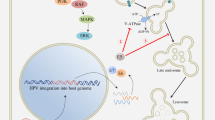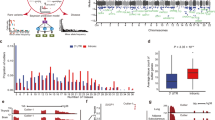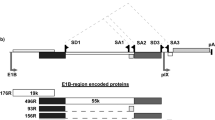Abstract
The human adenoviruses are classified according to their nucleotide sequence homology and their oncogenic potential in rodents1,2. The left-hand end of the genome of the adenovirus types 5 (ad5), 7 (ad7) and 12 (ad12), which are respectively, non-oncogenic (subgroup C), weakly oncogenic (subgroup B) and highly oncogenic (subgroup A)3–5, contains all the genetic information needed to induce and maintain the transformed phenotype. This part of the genome contains the early transcription unit designated E1 which is subdivided into two transcription units E1A and E1B6. Two spliced mRNAs are transcribed from the E1A region which codes for several phos-phorylated polypeptides. These polypeptides play a key role by controlling the expression of the other early transcription units7,8. The major role of region E1A in adenovirus cell transformation might be to activate the true transforming genes of the region E1B. An additional role probably consists of the activation of some cellular genes as a restriction fragment containing this region can immortalize rodent cells in vitro. An important question is why some adenoviruses are oncogenic and others are not. We report here differences in the structures of the E1A polypeptides from ad7 and adl2, compared to ad5, which may partially account for their differing oncogenicity.
This is a preview of subscription content, access via your institution
Access options
Subscribe to this journal
Receive 51 print issues and online access
$199.00 per year
only $3.90 per issue
Buy this article
- Purchase on SpringerLink
- Instant access to full article PDF
Prices may be subject to local taxes which are calculated during checkout
Similar content being viewed by others
References
Mackey, J., Wold, W., Rigden, P. & Green, M. J. Virology 29, 1056–1064 (1979).
Van der Eb, A. J. et al. Cold Spring Harb. Symp. quant. Biol. 44, (1979).
Graham, F. L. et al. Cold Spring Harb. Symp. quant. Biol. 39, 637–650 (1974).
Sekikawa, K., Shiroki, K., Shimojo, H., Ojima, S. & Fujinaga, K. Virology 88, 1–7 (1978).
Shiroki, K. et al. Virology 82, 462–471 (1977).
Wilson, M. C., Fraser, M. W. & Darnell, J. E. Virology 94, 175–184 (1979).
Jones, N. & Shenk, T. Proc. natn. Acad. Sci. U.S.A. 76, 3665–3669 (1979).
Berk, A. J., Lai, F., Harrison, T., Williams, J. & Sharp, P. A. Cell 17, 935–944 (1979).
Perricaudet, M., Akusjarvi, G., Virtanen, A. & Petterson, U. Nature 281, 694–696 (1979).
Dijkema, R., Dekker, B. M. M. & Van Ormondt, H. Gene 9, 141–156 (1980).
Fujinaga, K. et al. Cold Spring Harb. Symp. quant. Biol. 44, (1979).
Seif, I., Khoury, G. & Dhar, R. Nucleic Acids Res. 6, 3387–3398 (1979).
Van Ormondt, H., Maat, J., De Waard, A. & Van der Eb, A. J. Gene 4, 309–328 (1978).
Persson, H., Pettersson, U. & Mathews, M. G. Virology 90, 60–79 (1978).
Maxam, A. & Gilbert, W. Proc. natn. Acad. Sci. U.S.A. 74, 560–564 (1977).
Proodfoot, N. J. & Brownlee, G. G. Nature 263, 211–214 (1976).
Sugisaki, H. et al. Cell 20, 777–786 (1980).
Baker, C. & Ziff, E. Cold Spring Harb. Symp. quant. Biol. 44 (1980).
Author information
Authors and Affiliations
Rights and permissions
About this article
Cite this article
Perricaudet, M., le Moullec, JM., Tiollais, P. et al. Structure of two adenovirus type 12 transforming polypeptides and their evolutionary implications. Nature 288, 174–176 (1980). https://doi.org/10.1038/288174a0
Received:
Accepted:
Issue date:
DOI: https://doi.org/10.1038/288174a0



